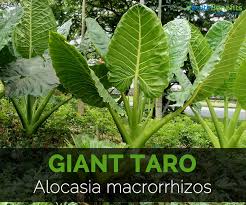Giant Taro
 Saturday 19 November 2016
Saturday 19 November 2016
Other Local Name : Giant Taro
Botanical Name : Alocasia macrorrhiza/ Alocasia indica
Family : Araceae
Main Use : Food and Medicine
Other Uses : Food and Medecin
Know More
Giant Taro is an annual herb. New plant emerges from the stem. Aerial stem grows upto 1-3 meters long. Leaves comes out of the stem. The leaves are triangular in shape. Flowers are fragrant. The fruit is berry.
Distribution : Center of origin of giant taro is South-East Asia. Later it was distributed in the Pacific Islands. Here it was used as a vegetable. Gradually it was extended in tropical and sub-tropical Asia including India, Myanmar,Malaysia, Indonesia, Philippines, and China . In the distant past it was distributed in Egypt , mediterranean region, Africa, Gulf of Guinea and upto Carribean islands. At present giant taro is the staple food in many Pacific island countries including Papua New Guinea. Giant taro is extensively distributed in rural Bangladesh in homestead areas, on the bank of pond and near the fences.
Flowering and fruiting :Giant taro bears flowers and fruits in the beginning of winter season.
Edible parts :Stem,petiole and young leaves are used as vegetables.
Chemical contents :The major chemical contents of giant taro include glucose, fructose, campesterol, cholesterol, trigluchytin, alcalloid,etc.
Nutrient composition : Per 100 grams of giant taro, there are - energy:116 k calories; carbohydrate : 27.52 grams; Vitamin B6 : 0.23 mg ; Vitamin B1 :0.099 mg ; copper : o.179 mg; manganese : o.398 mg ; Vitamin E : 2.48 mg ; potassium : 615 mg ; threonine : 0.072 mg ; leucine : 0.115 mg and lycine : 0.07 mg .
Giant taro is a vegetable very rich in minerals. It contains calcium, potassium, magnesium, manganese, iron, zinc, copper, protein, bia-carotene, thiamin, Vitamin A, Vitamin C, Vitamin D, Vtamin E, Vitamin B2, and Vitamin B6.
Medicinal attributes of giant taro :
a) Inflamation and body pain are cured with gentle application of worm giant taro leaf; b) Lesion on tongue is treated with a mixture of giant taro ash and mustard oil ; c)Intake of giant taro cures anaemia through its rich content of iron and vitamins ; d) Leaf extract of giant taro -6 grams mixed with 120 cc cows milk are offered for treatment of spleen inflamation; e) cancer prevention- giant taro is rich in antioxident, Vitamin A, Vitamin C, and phenolic antioxident ,these components prevent cancer ; f ) rheumatoid- Vitamin B 6 in giant taro is very effective for curing muscle and joint pain ; g)cardiovascular disease and high blood pressure - Giant taro is very rich in Potassium which smoothly regulates the flow of blood vessels and reduces the risk of heart disease ; h) digstive power-there is high quality fiber in giant taro which aids better assimilation of food ; i )memory improvement - giant taro is rich in Vitamin B 1, that strengthens brain efficiency; j) eye power- betacarotene and cryptoxanthin present in giant taro improve eye power; k) dental health- phosphorus, calcium, and Viamin D present in giant taro improve dental power; l ) diabetes- giant taro regulates glycemic index of carbohydeate in food and thus reduces the risk of diabetes; m) hair health -there is Vitamin E in giant taro, it is a strong antioxidant and thus helps maintaining hair ; n )treating anaemia - there are many potential minerals in giant taro .The presence of iron and copper is important for treating anaemic patients ; o) checking bone degeneration - there is enough zinc, copper, calcium and manganese in giant taro . These minerals helps maintaining good bone health and p ) skin health-there are enough Vitamin A and Vitamin E in giant taro which help maintaining excellennt skin health. _